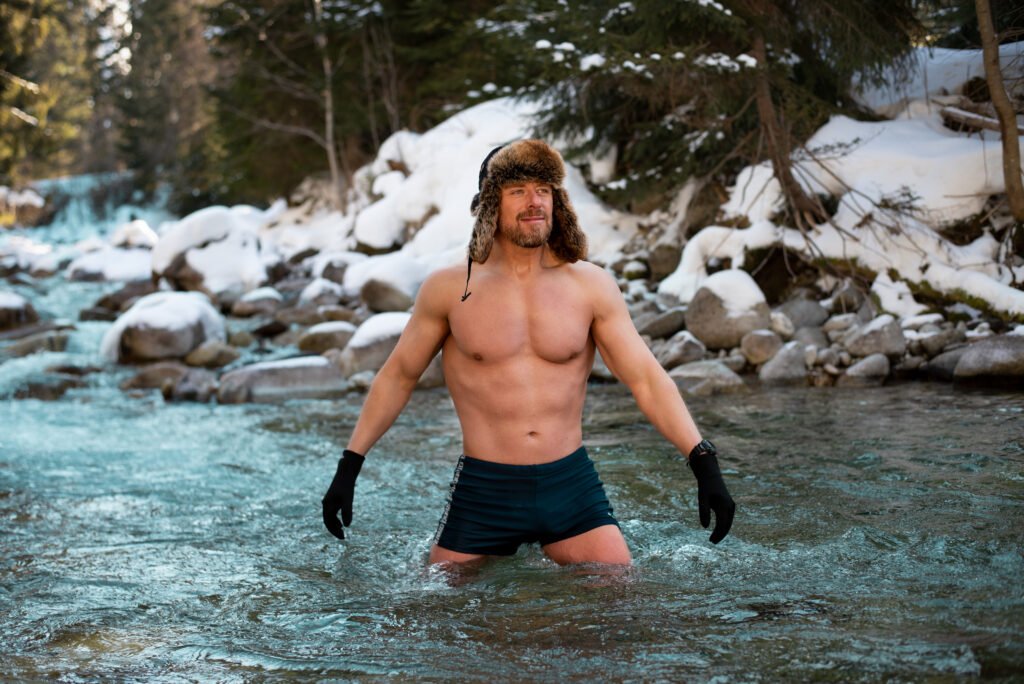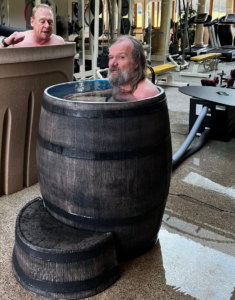
What Should Be Your Cold Plunge Temperature – 2024 Guide
Cold Plunge Temperature:
In the realm of cold plunging, temperature reigns supreme as the guiding force behind its therapeutic efficacy. in this growing trend the wuestion is still not clear for many of the loyal follower: what is the ideal cold plunge temperature

Delving into the science, safety considerations, practical applications, and a gradual adaptation plan for cold plunge temperature unveils a nuanced approach essential for reaping its full benefits while safeguarding well-being.
Table of Contents
What Should’nt Be Your Cold Plunge Temperature
- Avoid Extreme Cold Temperatures: Do not use water temperatures below 50°F (10°C). Extremely cold water can cause shock and increase the risk of hypothermia.
- Sudden Temperature Changes: Do not plunge into very cold water without gradual exposure. Start with moderate temperatures and gradually lower the temperature to allow your body to acclimate.
- Prolonged Exposure: Avoid staying in the cold plunge for too long, especially as a beginner. Limit your time to 1-3 minutes initially and gradually increase as your tolerance builds to prevent hypothermia.
- Ignoring Safety Precautions: Do not ignore safety guidelines such as avoiding hyperventilation or holding your breath while in the cold water. These practices can lead to dangerous situations.
- Skipping Warm-up and Cool-down Phases: Do not skip the warm-up before the cold plunge and the gradual cool-down afterward. This helps your body adjust and prevents shock.
- Inconsistent Temperature Maintenance: Avoid fluctuating the temperature wildly during your session. Maintain a steady temperature range (50-59°F or 10-15°C) to ensure a safe and effective cold plunge experience
Introduction: The Crucial Role of Temperature
Temperature
Acts as the cornerstone therapy, the cold plunge , shapintemperature influenceine the body’s physiological responses and therapeutic outcomes.
Optimal cold plunge temperature ranges are pivotal for reducing inflammation, alleviating muscle soreness, enhancing circulation, and promoting overall vitality.
Cold immersion within precise temperature parameters initiates a cascade of effects that contribute to its therapeutic potency.
Inflammation Management
Optimal cold plunge temperatures coax blood vessels to constrict, diminishing inflammatory markers and reducing discomfort.
Cold immersion helps to quell inflammation, fostering comfort and mobility within the body.
Muscle Soreness Alleviation:
The cooling embrace of cold water within optimal temperatures releases muscle tension and fatigue. Cold immersion soothes sore muscles, restoring suppleness and promoting relaxation.
Circulation Enhancement:
Under optimal cold plunge temperature conditions, cold immersion stimulates circulation, invigorating veins and arteries. Enhanced circulation ensures the efficient delivery of oxygen-rich blood to tissues and organs, promoting vitality.
Vitality Revitalization:
Within optimal cold plunge temperature awakens vitality, infusing the body with renewed energy and resilience. The transformative power of cold immersion revitalizes the body, empowering individuals to embrace each day with vigor and vitality.

Understanding the Therapeutic Range
Temperatures spanning 10-15 degrees Celsius or 50-59 degrees Fahrenheit stand out as the optimal range for cold plunge therapy.
Navigating Risks at Extreme Temperatures: Balancing Benefits and Hazards
Colder temperatures present heightened risks of hypothermia and frostbite, underscoring the importance of careful in your cold plunge temperature selection in your therapy.
Achieving optimal therapeutic outcomes requires striking a delicate equilibrium between the potential benefits of colder temperatures and the associated risks.
Understanding the Hazards:
Exposure to extremely cold temperatures increases the risk of hypothermia, a dangerous condition characterized by a drop in body temperature.
Frostbite, another potential hazard, can occur when skin and tissues freeze due to prolonged exposure to cold temperatures.
Prudent Temperature Selection:
Prudence dictates selecting temperatures that offer therapeutic benefits without exposing oneself to undue risks.
Individuals must assess their tolerance levels, desired therapeutic outcomes, and overall comfort to determine the most suitable temperature range for cold plunge therapy.
Benefits of Colder Temperatures:
While colder temperatures may provide enhanced therapeutic benefits, such as heightened inflammation reduction and muscle recovery, they also entail greater risks.
It is essential to weigh these benefits against the potential hazards and exercise caution when opting for colder temperature ranges.
Individualized Approach:
Your Cold plunge temperature is not one-size-fits-all, and temperature selection should be tailored to individual needs and preferences.
By considering factors such as personal tolerance, health status, and desired outcomes, individuals can make informed decisions regarding the cold plunge temperature selection.
Gradual Acclimatization:
For those interested in exploring colder temperature ranges, a gradual acclimatization approach is advisable.
Starting with milder cold plunge temperature and gradually lowering the temperature over time allows the body to adapt safely to colder immersion.
Monitoring and Adjustment:
Continuous monitoring of one’s response to cold immersion is essential for mitigating risks and optimizing benefits.
Individuals should be vigilant for signs of discomfort, numbness, or adverse reactions and adjust temperature and duration accordingly.
Consultation with Healthcare Professionals:
Individuals with pre-existing medical conditions or concerns should consult healthcare professionals before engaging in cold plunge therapy.
Healthcare providers can offer personalized guidance and recommendations to ensure safe and effective temperature selection for cold immersion sessions.

Customizing Your Cold Plunge Temperature: Factors to Consider
Customizing the cold plunge experience involves careful consideration of several factors to optimize therapeutic benefits and ensure safety.
- Individual Cold Tolerance
Understanding one’s tolerance to cold water is fundamental in customizing the cold plunge experience.
Factors such as previous exposure to cold water, age, body composition, and overall health can influence individual cold tolerance levels.
Desired Therapeutic Outcomes:
Identifying specific therapeutic goals is crucial for tailoring the cold plunge regimen to meet individual needs.
Whether aiming to reduce inflammation, alleviate muscle soreness, enhance recovery, or improve overall well-being, aligning the temperature and duration of the plunge with desired outcomes is essential.
Overall Health Status:
Individuals with pre-existing medical conditions or concerns should consider their overall health status when customizing their cold plunge experience.
Consulting with healthcare professionals can provide valuable insights into potential risks, contraindications, and appropriate temperature ranges for safe immersion.
Practical Considerations:
Practical logistics, such as the availability of equipment, resources, and facilities, also play a role in customizing the cold plunge regimen.
Factors like access to ice baths, thermometers for temperature monitoring, and appropriate clothing for post-plunge warming should be taken into account.
Integration of Factors:
Customizing the cold plunge experience involves integrating various factors to create a personalized and effective regimen.
By considering individual tolerance, therapeutic goals, health status, and practical logistics, individuals can tailor their cold plunge temperature throught sessions to optimize benefits and ensure safety.
Gradual Progression:
Implementing a gradual progression plan allows individuals to safely customize their cold plunge experience over time.
Starting with milder temperatures and shorter durations and gradually increasing intensity and duration as tolerance improves can help prevent adverse reactions and enhance adaptation to cold immersion.
Flexibility and Adaptation:
Flexibility and adaptation are key principles in customizing the cold plunge temperature for the best benefits.
Being open to adjusting temperature, duration, and frequency based on individual responses and evolving goals ensures a dynamic and effective cold plunge experience.
Continuous Evaluation:
Regular evaluation of the customized cold plunge regimen is essential for monitoring progress and making necessary adjustments.
Tracking changes in tolerance, therapeutic outcomes, and overall well-being allows individuals to refine their approach and maximize the benefits of cold immersion over time.

A Blueprint for Success: Gradual Adaptation Plan
Embarking on a cold plunge journey demands a structured adaptation plan to ensure safety, efficacy, and long-term adherence. Beginners should initiate their journey with shorter exposure times and warmer cold plunge temperature, gradually progressing to colder temperatures and longer durations over time. A suggested progression plan could include:
- Week 1:
- Duration: 5 minutes
- Temperature: 15°C (59°F)
- Description: Begin with a gentle introduction to cold immersion by starting with a relatively warmer temperature and a short duration to allow the body to adjust gradually.
- Week 2:
- Duration: 7 minutes
- Temperature: 13°C (55°F)
- Description: Increase the duration slightly while slightly reducing the water temperature to continue acclimating the body to colder temperatures.
- Week 3:
- Duration: 10 minutes
- Temperature: 11°C (52°F)
- Description: Extend the duration further and lower the temperature incrementally to challenge the body’s tolerance to cold immersion.
- Week 4:
- Duration: 12 minutes
- Temperature: 10°C (50°F)
- Description: Gradually progress to colder temperatures and longer durations to optimize the therapeutic benefits of cold water immersion while minimizing the risk of adverse reactions.

This gradual approach allows the body to adapt progressively to the cold, minimizing the risk of hypothermia or other adverse effects while maximizing the potential benefits of cold plunge therapy. By following this structured progression plan, individuals can safely and effectively integrate cold immersion into their wellness routine, promoting overall health and well-being over time.
6. Ensuring Safety and Maximizing Benefits
Safety is paramount in the practice of cold plunge therapy, requiring careful attention to detail and a proactive approach to minimize risks and maximize benefits. Here’s how to ensure safety while optimizing the transformative potential of cold immersion:
Gradual Acclimatization:
Begin with shorter exposure times and warmer water cold plunge temperature, gradually increasing both duration and coldness over time will Allow your body to adapt gradually to the cold, minimizing the risk of adverse reactions while maximizing the benefits of cold water immersion.
Vigilant Temperature Monitoring:
Use a reliable thermometer to monitor the water temperature throughout the cold plunge session. Ensure that the water temperature remains within the safe range to prevent hypothermia or other cold-related injuries.
Attentive Response to Bodily Cues:
Listen to your body and pay attention to any signs of discomfort or distress during the cold plunge. If you experience numbness, tingling, or extreme cold sensations, exit the cold water immediately and warm up gradually.
Prioritize Safety Alongside Efficacy:
Strike a balance between pushing your limits and staying within a comfortable and safe range.
Remember that safety should always come first, even as you strive to maximize the therapeutic benefits of cold immersion.
By prioritizing safety alongside efficacy, individuals can unlock the transformative potential of cold plunge therapy while safeguarding their well-being. With a proactive approach to safety measures and a gradual progression plan, you can reap the full benefits of cold immersion and enhance your overall health and vitality.
7. Guidelines for Safe Cold Plunges
Embarking on a cold plunge journey demands adherence to safety guidelines and best practices to mitigate potential risks. From gradual adaptation to temperature modulation and attentive post-plunge care, implementing these guidelines ensures a secure and rewarding cold plunge experience.
- Gradually increase exposure time and coldness level over several weeks.
- Always monitor your body’s response and exit the cold plunge if you experience discomfort or adverse symptoms.
- Consult with a healthcare professional before starting a cold plunge regimen, especially if you have pre-existing health conditions.
- Use a thermometer to monitor water temperature accurately and ensure it remains within the safe range.
- Practice gradual cooling techniques before entering the cold plunge, such as cold showers or exposure to cool air, to prepare your body for the temperature change.
- Stay hydrated before and after the cold plunge to support circulation and recovery.
- Consider wearing protective gear such as neoprene gloves and socks to minimize heat loss from extremities.

Conclusion: Embracing the Therapeutic Chill
In conclusion, the temperature of cold plunges serves as a linchpin in optimizing its therapeutic benefits while navigating potential risks. By embracing the science, safety protocols, practical considerations, and a gradual adaptation plan surrounding cold plunge temperature, individuals can embark on a journey of rejuvenation and vitality, harnessing the transformative power of the therapeutic chill.




Awesome blog! Is your theme custom made or didd you download it from somewhere?
A theme like yours with a few simple adjustements would
really make my blog jump out. Please let me know where you
got your theme. With thanks https://www.waste-ndc.pro/community/profile/tressa79906983/